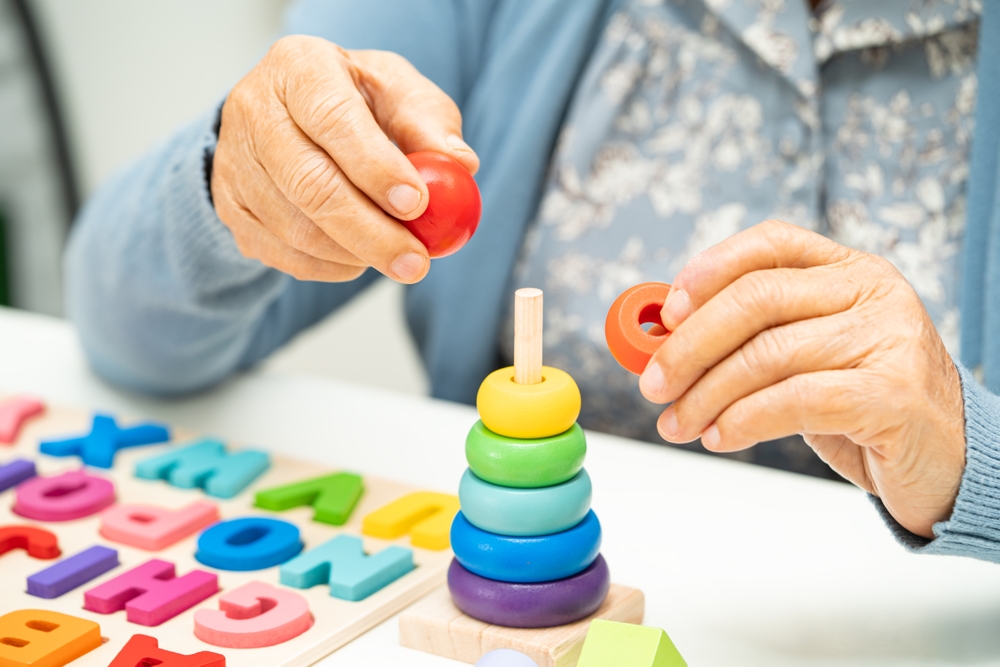Dementia can lead to a decline in cognitive and sensory processing abilities, often resulting in agitation, confusion, and isolation. Sensory stimulation activities are an effective, non-pharmacological approach to managing these symptoms. By engaging the senses through structured activities, caregivers can help individuals with dementia reconnect with their environment, trigger positive memories, and improve overall emotional well-being. In this blog, we explore a range of sensory stimulation activities that are tailored to support dementia care and enhance quality of life.

Understanding Dementia and Sensory Challenges
What is Dementia?
Dementia is a progressive condition that affects memory, cognition, and the ability to perform everyday tasks. As dementia advances, individuals may struggle with processing sensory information, leading to difficulties in communication, increased agitation, and disorientation.
Common Sensory Challenges in Dementia
Impaired Sensory Processing:
Difficulty interpreting visual, auditory, or tactile information.
Heightened Sensitivity:
Over-responsiveness to sensory input such as bright lights or loud noises, which can lead to discomfort.
Reduced Engagement:
A decline in sensory stimulation can result in withdrawal and a decrease in overall interaction with the environment.
Understanding these challenges is crucial for implementing effective sensory stimulation activities that can support cognitive function and emotional well-being.

The Importance of Sensory Stimulation for Dementia Care
Sensory stimulation is more than just an activity, it’s a way to reconnect individuals with their surroundings and evoke positive memories. When appropriately applied, sensory activities can:
Enhance Mood and Reduce Agitation:
Gentle stimulation can soothe and calm, reducing anxiety and irritability.
Improve Communication and Social Interaction:
Engaging multiple senses often sparks conversation and social engagement.
Stimulate Cognitive Function:
Activities that challenge the senses can help maintain cognitive function and slow cognitive decline.
Increase Overall Wellbeing:
A balanced sensory environment promotes comfort, reduces feelings of isolation, and supports emotional resilience.
By prioritising sensory stimulation, caregivers can create a more enriching and supportive environment that fosters dignity and joy in individuals with dementia.

Core Sensory Stimulation Activities
A variety of sensory stimulation activities can be tailored to the unique needs of individuals with dementia. Here are some key approaches:
1. Tactile Stimulation
Engage in activities that involve touch, such as handling soft fabrics, playing with textured objects like stress balls or sensory bins filled with rice, or even gentle hand massages.
Benefits:
- Promotes relaxation and reduces agitation.
- Helps stimulate memory through familiar textures.
- Enhances hand-eye coordination.
Learn more about tactile stimulation at Cerebral Palsy Alliance – Sensory Tools.
2. Auditory Stimulation
Incorporate music therapy, listening to familiar songs, nature sounds, or using white noise machines. Interactive auditory games and simple rhythm exercises can also be effective.
Benefits:
- Can evoke positive memories and emotions.
- Reduces stress and anxiety.
- Enhances communication and social interaction.
For more on music therapy in dementia care, visit Alzheimer’s Australia.
3. Visual Stimulation
Use colourful and high-contrast visual aids, picture boards, or reminiscence therapy through photos and videos of past events. Light therapy and calming visual displays can also be beneficial.
Benefits:
- Helps maintain visual engagement and stimulate cognitive recall.
- Reduces feelings of isolation through familiar visual cues.
- Can improve mood and attention.
4. Multisensory Engagement
Combine multiple sensory inputs in one activity, for example, a cooking session that involves tactile (handling ingredients), olfactory (smelling spices), and visual stimulation (colourful produce).
Benefits:
- Enhances overall engagement by activating multiple senses.
- Helps maintain cognitive function through complex, real-world tasks.
- Provides a richer, more immersive experience that can evoke positive memories and emotions.
For further insights on multisensory stimulation, check out NDIS – Sensory Integration.
5. Reminiscence Therapy
Utilise objects, music, photos, and familiar scents to trigger memories and encourage storytelling. Reminiscence therapy sessions can be both structured and informal, aimed at creating a positive emotional connection.
Benefits:
- Helps preserve personal identity and history.
- Stimulates cognitive recall and social interaction.
- Reduces anxiety by providing a comforting link to the past.
Learn more about reminiscence therapy at Australian Psychological Society.

How to Incorporate Multisensory Engagement in Daily Routines
Implementing sensory stimulation activities consistently is key to their success. Consider these strategies:
Scheduled Sensory Sessions:
Integrate sensory activities into your daily or weekly routine to ensure regular engagement.
Personalised Activity Plans:
Tailor activities to the individual’s history, preferences, and sensory needs. For example, use favourite music or photos from the past to enhance the emotional impact.
Environmental Enhancements:
Adapt the living space to include sensory-friendly elements such as soft lighting, accessible sensory tools, and dedicated spaces for relaxation and engagement.
Family Involvement:
Encourage family members to participate in sensory activities, fostering a supportive environment and creating opportunities for meaningful interaction.

Frequently Asked Questions
What are sensory stimulation activities?
Sensory stimulation activities are exercises and interventions designed to engage the senses, such as touch, sight, sound, and smell, to promote cognitive function, reduce agitation, and improve emotional well-being in individuals with dementia.
How do these activities benefit individuals with dementia?
By engaging the senses, these activities help maintain cognitive function, evoke positive memories, reduce anxiety, and enhance overall emotional balance. They can also foster social interaction and improve the quality of daily life.
How often should sensory stimulation activities be performed?
The frequency can vary based on individual needs, but incorporating them into daily or weekly routines consistently is beneficial for maintaining engagement and cognitive function.
Can caregivers implement these activities at home?
Yes, many sensory stimulation activities are designed to be easily implemented at home. Caregivers can adapt activities to the individual’s preferences and abilities to ensure maximum engagement.
Are sensory stimulation activities supported by research?
Yes, extensive research supports the use of sensory stimulation in dementia care, highlighting its benefits in reducing agitation, improving cognitive recall, and enhancing overall well-being.

Conclusion
Sensory stimulation activities offer a powerful, non-pharmacological approach to enhancing the quality of life for individuals with dementia. By engaging the senses through tactile, auditory, visual, and multisensory experiences, caregivers can help maintain cognitive function, evoke positive memories, and create a more calming and supportive environment. Regular implementation of these activities, tailored to the individual's unique history and preferences, can significantly reduce agitation and improve emotional well-being.
Empowering individuals with dementia through sensory engagement not only enhances their daily experience but also supports caregivers in providing compassionate, effective care. By incorporating these research-backed strategies into your routine, you can make a meaningful difference in the lives of those living with dementia.
Take the Next Step:
If you’re ready to explore how sensory stimulation can enhance dementia care, contact us today. To learn more about our comprehensive services, please explore:

Date Published: Tuesday, April 1, 2025
Locate a Aged Care Exercise Physiology
Service Near me
Get the experience & convinence you deserve to support your or a loved one's allied health needs.
Our Aged Care Exercise Physiology team are currently serving & taking appointments in the following states and regions in Australia:
New South Wales
- Blacktown
- Blue Mountains
- Campbelltown And Macarthur
- Canterbury-Bankstown
- Central Coast
- Eastern Suburbs Sydney
- Georges River
- Hawkesbury
- Inner East Sydney
- Inner West Sydney
- Lower North Shore
- Newcastle
- Northern Beaches
- North Sydney
- Parramatta
- Penrith
- South West Sydney
- Sutherland Shire
- Sydney CBD
- The Hills Shire
- Upper North Shore
- Waverley
- Wollongong
Tasmania
Victoria
Need to get into direct contact with ur Client Services team? We're all ears. Call our team directly on 1300 731 733







